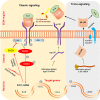Pathogenesis and management of abdominal aortic aneurysm
- PMID: 37387260
- PMCID: PMC10393073
- DOI: 10.1093/eurheartj/ehad386
Pathogenesis and management of abdominal aortic aneurysm
Abstract
Abdominal aortic aneurysm (AAA) causes ∼170 000 deaths annually worldwide. Most guidelines recommend asymptomatic small AAAs (30 to <50 mm in women; 30 to <55 mm in men) are monitored by imaging and large asymptomatic, symptomatic, and ruptured AAAs are considered for surgical repair. Advances in AAA repair techniques have occurred, but a remaining priority is therapies to limit AAA growth and rupture. This review outlines research on AAA pathogenesis and therapies to limit AAA growth. Genome-wide association studies have identified novel drug targets, e.g. interleukin-6 blockade. Mendelian randomization analyses suggest that treatments to reduce low-density lipoprotein cholesterol such as proprotein convertase subtilisin/kexin type 9 inhibitors and smoking reduction or cessation are also treatment targets. Thirteen placebo-controlled randomized trials have tested whether a range of antibiotics, blood pressure-lowering drugs, a mast cell stabilizer, an anti-platelet drug, or fenofibrate slow AAA growth. None of these trials have shown convincing evidence of drug efficacy and have been limited by small sample sizes, limited drug adherence, poor participant retention, and over-optimistic AAA growth reduction targets. Data from some large observational cohorts suggest that blood pressure reduction, particularly by angiotensin-converting enzyme inhibitors, could limit aneurysm rupture, but this has not been evaluated in randomized trials. Some observational studies suggest metformin may limit AAA growth, and this is currently being tested in randomized trials. In conclusion, no drug therapy has been shown to convincingly limit AAA growth in randomized controlled trials. Further large prospective studies on other targets are needed.
Keywords: AAA rupture; Abdominal aortic aneurysm; IL-6; Metformin; RAS; Single-nucleotide polymorphism.
© The Author(s) 2023. Published by Oxford University Press on behalf of the European Society of Cardiology.
Figures








References
-
- Wanhainen A, Verzini F, Van Herzeele I, Allaire E, Bown M, Cohnert T, et al. Editor’s choice—European Society for Vascular Surgery (ESVS) 2019 clinical practice guidelines on the management of abdominal aorto-iliac artery aneurysms. Eur J Vasc Endovasc Surg 2019;57:8–93. 10.1016/j.ejvs.2018.09.020 - DOI - PubMed

